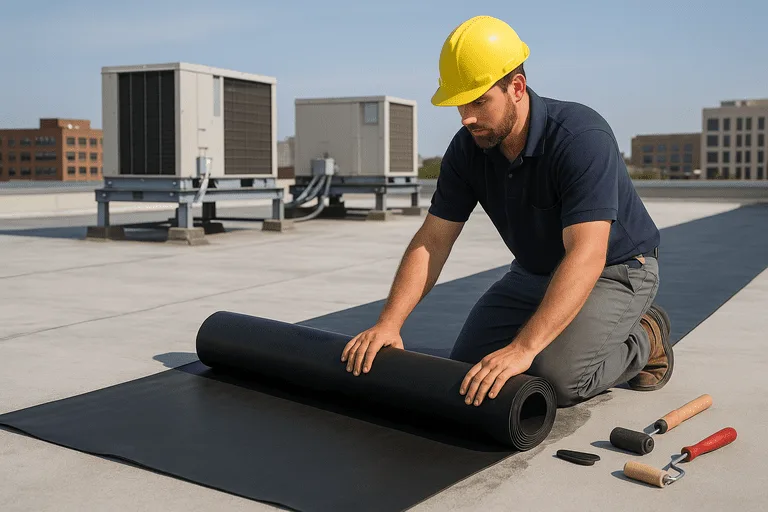“Is your flat roof truly sealed, or is it just waiting for the next rainstorm to prove otherwise?”

Rubber roofing, especially EPDM (ethylene propylene diene monomer), has become a go-to solution for flat and low-slope roofs across both residential and commercial buildings. But for many homeowners and even some HVAC professionals, the question remains: how exactly do you install rubber roofing properly? And why is this method gaining so much traction in the industry?
In this post, we’ll walk you through the “rubber roofing how to” process, explore its relevance for HVAC systems and property maintenance, discuss key benefits and common challenges, and provide actionable insights for contractors, business owners, and DIY-enthusiasts.
Why Rubber Roofing Matters
Rubber roofing, especially in EPDM format, is lightweight, durable, and surprisingly cost-effective. It’s estimated that over 1 billion square feet of EPDM roofing is installed annually in United Kingdom alone (source: EPDM Roofing Association). With proper installation, EPDM can last up to 50 years, making it a low-maintenance, long-term investment.
For HVAC technicians and building contractors, understanding rubber roofing is critical, not just for the roof itself but for the systems installed on top of it. Rooftop units (RTUs), ducting, and cold room condensers all depend on watertight roofing beneath. Improper installation can lead to leaks, system failure, mould issues, and significant repair costs.
Case Study from a Commercial HVAC Rooftop Project
In a recent project by a mid-sized HVAC company in the Midlands, a commercial property required a new rubber roof installation before installing four RTUs for cold storage. The team chose 60-mil EPDM rubber due to its flexibility and heat resistance.
Outcome:
Installation took 2 days, including flashing and perimeter sealing.
System passed all leak and pressure tests.
Post-installation, the property saw a 28% improvement in energy efficiency, largely due to better insulation and roofing integrity.
Step-by-Step Guide: Rubber Roofing How-To
1. Preparation
Start by cleaning the roof deck. It must be dry, free of debris, and structurally sound.
Pro Tip: Moisture trapped beneath the rubber membrane can lead to blistering. Always test for damp areas before application.
2. Measuring & Cutting
Roll out the EPDM membrane and allow it to relax for 30 minutes to an hour. Cut to size, ensuring at least 3 inches of overlap at seams.
3. Adhesive Application
Apply bonding adhesive to both the roof surface and the underside of the EPDM. Wait until it’s tacky—never wet—before bonding.
Avoid This Mistake: Some installers skip the waiting step and end up with bubbles or weak adhesion.
4. Laying the Membrane
Carefully roll the membrane back into place, smoothing out air bubbles with a broom or roller.
5. Sealing Seams and Edges
Use seam tape and apply with a seam roller to ensure watertight joints. Flashings should be installed around HVAC penetrations, drains, and parapets.
6. Final Inspection
Check all seams, edges, and flashing. Pour a small amount of water to test flow to drains.
Key Benefits of Rubber Roofing
Longevity: 30–50 years with minimal maintenance
Resilience: UV-resistant and performs well in extreme temperatures
Cost-effective: Less expensive than traditional flat roofing systems like BUR or modified bitumen
Environmentally Friendly: EPDM can be recycled and reused
Challenges and Considerations
DIY Complexity: While EPDM is easier than torch-down methods, seam work and flashing require precision.
Weather Dependency: Adhesive application is temperature and humidity sensitive.
HVAC Coordination: If installing rooftop units, coordinate with HVAC teams to avoid post-install punctures or system misalignment.
Expert Insight:
“We always recommend clients have HVAC installations planned after the rubber roofing is installed,” says Jamie Elwood, Project Manager at RoofSmart Ltd. “This avoids the ‘Swiss cheese’ effect of too many unnecessary penetrations.”
Who Needs to Know This?
Homeowners planning to DIY or oversee renovations
HVAC Technicians installing RTUs or rooftop components
Property Developers managing commercial real estate
Roofing Contractors seeking to upskill or adopt newer materials
Understanding rubber roofing ensures better project outcomes, fewer callbacks, and longer-lasting systems.
Who Needs to Know This?
Homeowners planning to DIY or oversee renovations
HVAC Technicians installing RTUs or rooftop components
Property Developers managing commercial real estate
Roofing Contractors seeking to upskill or adopt newer materials
Understanding rubber roofing ensures better project outcomes, fewer callbacks, and longer-lasting systems.
The Future of Flat Roofs
With rising energy costs and a shift toward sustainable building materials, EPDM and TPO rubber roofing systems are poised to dominate the flat roofing sector in the UK. Innovations like self-adhering membranes and cool roof coatings are making installations faster and more energy-efficient.
Actionable Takeaway:
If you’re in the roofing, HVAC, or building maintenance industry, invest time in mastering rubber roofing installation best practices. It’s no longer just a niche skill, it’s becoming an industry standard.